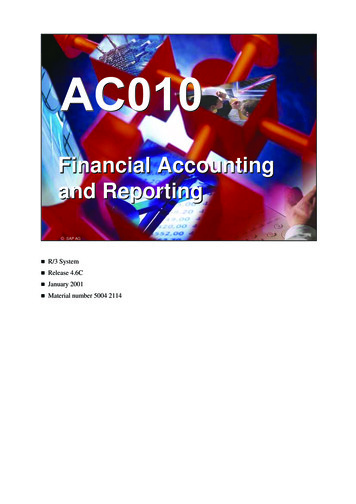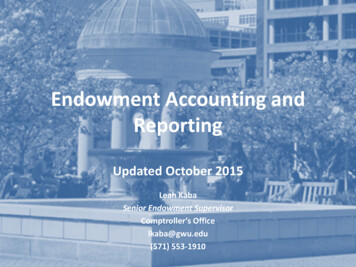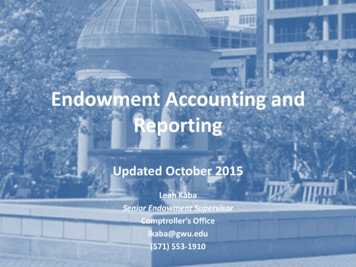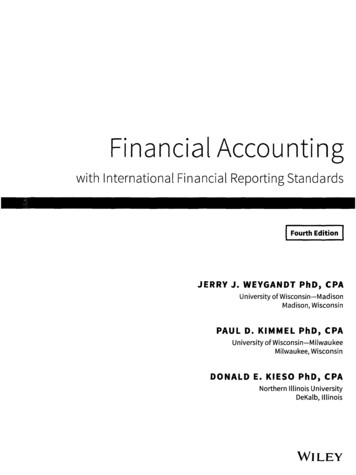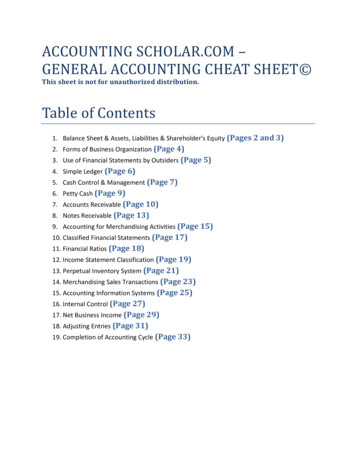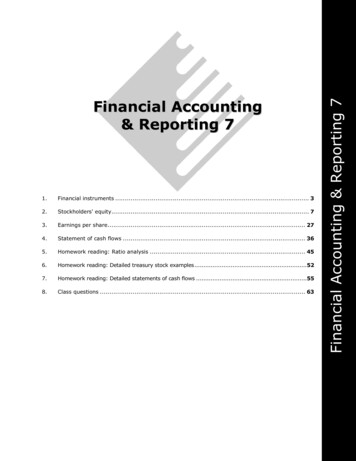
Transcription
1.Financial instruments . 32.Stockholders' equity. 73.Earnings per share. 274.Statement of cash flows . 365.Homework reading: Ratio analysis . 456.Homework reading: Detailed treasury stock examples.527.Homework reading: Detailed statements of cash flows .558.Class questions . 63Financial Accounting & Reporting 7Financial Accounting& Reporting 7
F7-2
Becker CPA ReviewFinancial Accounting & Reporting 7FINANCIAL INSTRUMENTSI.II.FINANCIALINSTRUMENTSTYPES OF FINANCIAL INSTRUMENTSA.Cash, Foreign Currency, and Demand DepositsB.Evidence of an Ownership Interest in an Entity (e.g., Stock Certificate, Partnership Interests,or Limited Liability Company (LLC) Interests)C.Contracts (or Series of Linked Contracts), Which Result in an Exchange of Cash orOwnership Interest in an EntityD.Derivatives (Financial Instruments Whose Value or Settlement Amount is Derived from theValue of Another Unit of Measure Covered in V, Below)FAIR VALUE DISCLOSURES REQUIRED FOR FINANCIAL INSTRUMENTSFair values must be disclosed for all financial instruments (except as noted below) for which it ispracticable to estimate that value, together with the related carrying amounts showing clearlywhether the amounts represent assets or liabilities.These disclosures apply to all entities (except non-public entities that have total assets lessthan 100 million and have no instruments that are accounted for as derivatives, as defined bySFAS No. 133).III.DISCLOSURES ABOUT "CONCENTRATION OF CREDIT RISK" OF ALLFINANCIAL INSTRUMENTSDISCLOSURESCredit risk is the possibility of loss from the failure of another party to perform according to theterms of a contract. Concentration of credit risk occurs when an entity has contracts of materialvalue with one or more parties in the same industry or region or having similar economiccharacteristics (e.g., a group of highly leveraged entities).A.REQUIREMENT TO DISCLOSEAll entities must disclose all significant concentrations of credit risk arising from all financialinstruments (except as noted in B), whether from a single party or a group of parties engagedin similar activities and that have similar economic characteristics.B.APPLICABILITYThese disclosures apply to all entities (except non-public entities that have total assets lessthan 100 million and have no instruments that are accounted for as derivatives, as definedby SFAS No. 133).IV.DISCLOSURE ABOUT "MARKET RISK" OF ALL FINANCIAL INSTRUMENTSMarket risk is the possibility of loss from changes in market value (not necessarily due to the failureof another party, but due to changes in economic circumstances).All entities are encouraged, but not required, to disclose quantitative information about the marketrisk of financial instruments that is consistent with the way it manages or adjusts those risks. 2009 DeVry/Becker Educational Development Corp. All rights reserved.F7-3
Financial Accounting & Reporting 7V.Becker CPA ReviewDERIVATIVE INSTRUMENTS AND HEDGING ACTIVITIES (SFASs No. 133 AND 149)SFAS No. 133 established accounting for derivative instruments and hedging activities. Itsrequirements apply to all entities, including not-for-profit organizations and pension plans.A.DEFINITIONS AND CONCEPTS1.Derivative InstrumentA "derivative instrument" is a financial instrument (or other contract) that "derives" itsvalue from the value of some other instrument and has all three of the followingcharacteristics:2.a.One or more underlyings and one or more notional amounts or paymentprovisions (or both), andb.It requires no initial net investment or one that is smaller than would be requiredfor other types of similar contracts, andc.Its terms require or permit a net settlement (i.e., it can be settled for cash in lieuof physical delivery), or it can readily be settled net outside the contract (e.g., onan exchange) or by delivery of an asset that gives substantially the same results(e.g., an asset readily convertible to cash).UnderlyingAn "underlying" is a specified price, rate, or other variable (e.g., interest rate, securityor commodity price, foreign exchange rate, index of prices or rates, etc.), including ascheduled event (e.g., a payment under contract) that may or may not occur.3.Notional AmountA "notional amount" is a specified unit of measure (e.g., currency units, shares,bushels, pounds, etc.).4.Value or Settlement AmountThe value or settlement amount of a derivative is the amount determined by themultiplication (or other arithmetical interaction) of the notional amount and theunderlying. For example, shares of stock times the price per share.5.Payment ProvisionA "payment provision" is a specified (fixed) or determinable settlement that is to bemade if the underlying behaves in a specified way.6.ExamplesThe following contracts are examples of common derivatives:F7-4a.Option contracts (e.g., a stock option that requires the maker to deliver stock at alater time in exchange for a fixed price)b.Forward contracts (e.g., similar to futures contracts, but between contractingparties, not through a clearinghouse)c.Futures contracts (e.g., to deliver a commodity or foreign currency in the future ata price stated at the present; made through a clearinghouse)d.Swap contracts (e.g., to exchange currencies, debt securities, etc.)e.Origination mortgage loan commitments that will be held for sale by the lender(issuer of the commitment) 2009 DeVry/Becker Educational Development Corp. All rights reserved.
Becker CPA ReviewVI.Financial Accounting & Reporting 7ACCOUNTING FOR DERIVATIVE INSTRUMENTS INCLUDING HEDGESA.BALANCE SHEETDERIVATIVEFINANCIALINSTRUMENTSAll derivative instruments are recognized in the balance sheet as either assetsor liabilities, depending on the rights or obligations under the contracts.All derivative instruments are measured at fair value.Accounting for changes in the fair value is dependent on whether the derivative has beendesignated and whether it qualifies as a hedge, combined with the reason for holding theinstrument.B.REPORTING GAINS AND LOSSES1.No Hedging DesignationGains/losses on a derivative instrument not designated as a hedging instrument arerecognized currently in earnings.2.Fair Value HedgeA fair value hedge is an instrument designated as hedging the exposure to changes infair value of an asset or liability or an identified portion thereof that is attributed to aparticular risk. Gains/losses on such instruments as well as the offsetting gain/loss onthe hedged item are recognized in earnings in the same accounting period. It mustalso be expected to be highly effective in offsetting the fair value change (that couldaffect income) of the hedged item.3.Cash Flow HedgeA cash flow hedge is an instrument designated as hedging the exposure to variability inexpected future cash flows attributed to a particular risk. Gains/losses on the effectiveportion of a cash flow hedge are deferred and are reported as a component of othercomprehensive income (outside earnings) until the cash flows associated with thehedged item are realized. Gains/losses on the ineffective portion of a cash flow hedgeare reported in current income.4.Foreign Currency HedgeA foreign currency hedge is an instrument designated as hedging the exposure tovariability in foreign currency in a variety of foreign currency transactions.a.Gains and losses from changes in the fair value of foreign currency transactionhedges classified as fair value hedges are accounted for in the same manner asgains/losses on other fair value hedges—in earnings.b.Gains and losses from changes in the fair value of foreign currency transactionhedges classified as cash flow hedges are accounted for in the same manner asgains/losses on cash flow hedges—in other comprehensive income for theeffective portion and current income for the ineffective portion.c.Gains and losses from changes in the fair value of foreign currency transactionhedges entered into to hedge a net investment in a foreign operation arereported in other comprehensive income as part of the cumulative translationadjustment, discussed in F-2. 2009 DeVry/Becker Educational Development Corp. All rights reserved.F7-5
Financial Accounting & Reporting 7C.Becker CPA ReviewREPORTING CASH FLOWSIf the derivative (e.g., hedge) contains an other-than-insignificant financing element atinception (which is often a matter of judgment), all cash flows associated with that derivativeshould be reported as cash flows from financing activities (per SFAS 95, as amended bySFAS 149), not just those related to the financing element. Otherwise, account for the cashflows from the derivative (e.g., hedge) in the same category as the item being hedged.PASS KEYHedging transactions are often quite complicated. However, the examiners tend to focus on the effects of the hedgingtransactions on the income statement or the balance sheet of the company. The following summary is a great way to getmany of the points of this topic.Type of Hedge InstrumentAccounting for Changes in Fair Value No hedge designationIncluded in current earnings Fair value hedgeIncluded in current earnings* Cash flow hedge:Effective portionIncluded in other comprehensive incomeIneffective portionIncluded in current earnings Foreign exchange hedge:Fair value hedgeIncluded in current earnings*Cash flow hedgeIncluded in other comprehensive income (effectiveportion)Net investment hedgeIncluded in other comprehensive income, as cumulativetranslation adjustment* Note: Changes in the value of the offsetting asset/liability are also included in current earnings.F7-6 2009 DeVry/Becker Educational Development Corp. All rights reserved.
Becker CPA ReviewFinancial Accounting & Reporting 7STOCKHOLDERS' EQUITYI.STOCKHOLDERS'EQUITYOVERVIEWStockholders' equity (also called shareholders' equity or owners' equity) is the owners' claim to thenet assets (i.e., assets minus liabilities) of a corporation. It is generally presented on the statementof financial position (balance sheet) as the last major section (following liabilities). The variouselements constituting stockholders' equity must be clearly classified according to source. Thestockholders' equity section of the balance sheet contains five major components: (1) capital stock(also called legal capital); (2) additional paid-in capital; (3) retained earnings or deficit; (4)accumulated other comprehensive income; and (5) treasury stock, which is accounted fordifferently, depending upon the method used by the company (detailed discussion follows).Capital CorpShareholders' Equity – December 31, 20XXCAPITAL STOCK (capital equal to par or stated value)Preferred stock, non-cumulative, 100 par value, authorized 1,000shares, issued and outstanding 500 shares 50,000Common stock, 10 par value, authorized 50,000 shares, issued 30,000shares of which 5,000 are held in the treasury300,000350,000ADDITIONAL PAID-IN CAPITAL (capital in excess of par or stated value)Excess of issue price over par value of common/preferred stock sold 29,000Excess of sales price over cost of treasury shares sold15,000Excess of FMV over par of stock issued as stock dividend20,000Defaulted stock subscriptions10,000FMV of common shares contributed by shareholders to corporation75,000FMV of fixed assets contributed by local government60,000209,000RETAINED EARNINGSAppropriated (reserved) for general contingencies50,000Appropriated (reserved) for possible future inventory decline20,000Appropriated (reserved) for plant expansion40,000Appropriated (reserved) for higher replacement cost of fixed assets60,000Unappropriated (unreserved)200,000370,000929,000ACCUMULATED OTHER COMPREHENSIVE INCOMELESS: COST OF SHARES IN TREASURYTOTAL SHAREHOLDERS' EQUITY10,000( 85,000) 854,000Note: The preceding example assumes that treasury stock is reported under the cost method. (If the par valuemethod is used to account for treasury stock, then treasury stock must be reported as a deduction from thesame class of stock.) A detailed discussion of the methods to account for treasury stock is presented in thismodule. 2009 DeVry/Becker Educational Development Corp. All rights reserved.F7-7
Financial Accounting & Reporting 7II.Becker CPA ReviewCAPITAL STOCK (LEGAL CAPITAL)CAPITALSTOCKLegal capital is the amount of capital that must be retained by the corporation for the protectionof creditors. The par or stated value of both preferred and common stock is legal capital and isfrequently referred to as "capital" stock.A.PAR VALUEGenerally, preferred stock is issued with a par value, but common stock may be issued withor without a par value. No-par common stock may be issued as true no-par stock or no-parstock with a stated value. Any excess of the actual amount received over the par or statedvalue of the stock is accounted for as additional paid-in capital.B.AUTHORIZED, ISSUED, AND OUTSTANDINGA corporation's charter contains the amounts of each class of stock that it may legally issue,and this is called "authorized" capital stock. When part or all of the authorized capital stock isissued, it is called "issued" capital stock. Because a corporation may own issued capitalstock in the form of treasury stock, the amount of issued capital stock in the hands ofshareholders is called "outstanding" capital stock. In summary, capital stock may be (1
Becker CPA Review Financial Accounting & Reporting 7 2009 DeVry/Becker Educational Development Corp. All rights reserved. F7-3 FINANCIAL INSTRUMENTS I. TYPES OF FINANCIAL INSTRUMENTS A. Cash, Foreign Currency, and Demand Deposits B. Evidence of an Ownership Interest in an Entity (e.g., Stock Certificate, Partnership Interests,



